engine SKODA ROOMSTER 2006 1.G Manual Online
[x] Cancel search | Manufacturer: SKODA, Model Year: 2006, Model line: ROOMSTER, Model: SKODA ROOMSTER 2006 1.GPages: 274, PDF Size: 48.64 MB
Page 243 of 274
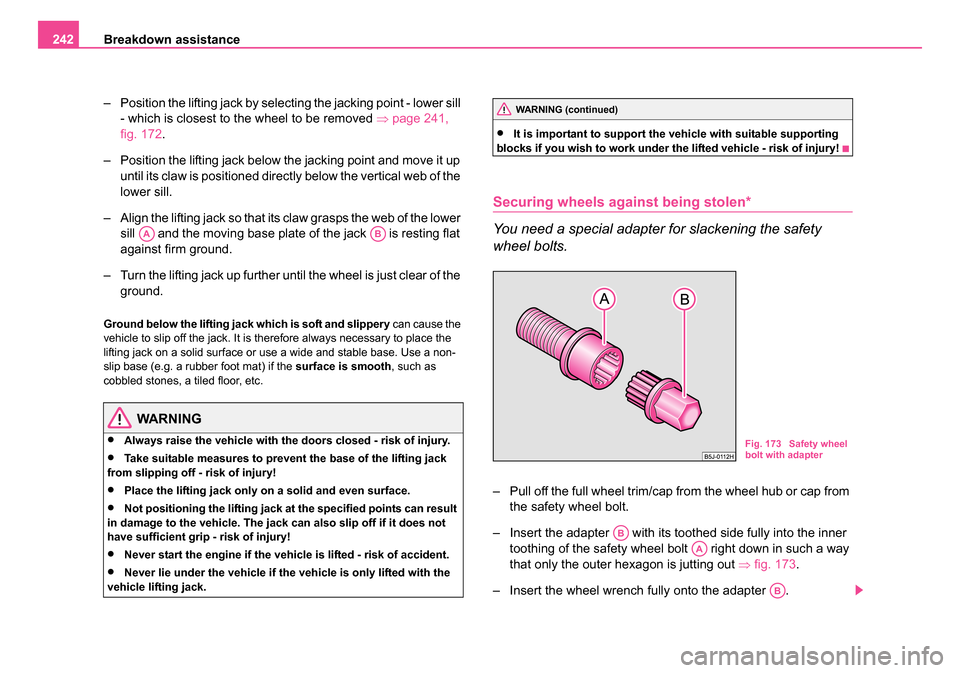
Breakdown assistance
242
– Position the lifting jack by selecting the jacking point - lower sill - which is closest to the wheel to be removed ⇒page 241,
fig. 172 .
– Position the lifting jack below the jacking point and move it up until its claw is positioned directly below the vertical web of the
lower sill.
– Align the lifting jack so that its claw grasps the web of the lower sill and the moving base plate of the jack is resting flat
against firm ground.
– Turn the lifting jack up further until the wheel is just clear of the ground.
Ground below the lifting jack which is soft and slippery can cause the
vehicle to slip off the jack. It is therefore always necessary to place the
lifting jack on a solid surface or use a wide and stable base. Use a non-
slip base (e.g. a rubber foot mat) if the surface is smooth, such as
cobbled stones, a tiled floor, etc.
WARNING
•Always raise the vehicle with the doors closed - risk of injury.
•Take suitable measures to prevent the base of the lifting jack
from slipping off - risk of injury!
•Place the lifting jack only on a solid and even surface.
•Not positioning the lifting jack at the specified points can result
in damage to the vehicle. The jack can also slip off if it does not
have sufficient grip - risk of injury!
•Never start the engine if the vehicle is lifted - risk of accident.
•Never lie under the vehicle if the vehicle is only lifted with the
vehicle lifting jack.
•It is important to support the ve hicle with suitable supporting
blocks if you wish to work under the lifted vehicle - risk of injury!
Securing wheels against being stolen*
You need a special adapter for slackening the safety
wheel bolts.
– Pull off the full wheel trim/cap from the wheel hub or cap from the safety wheel bolt.
– Insert the adapter with its toothed side fully into the inner toothing of the safety wheel bolt right down in such a way
that only the outer hexagon is jutting out ⇒fig. 173 .
– Insert the wheel wrench fully onto the adapter .
AAAB
WARNING (continued)
Fig. 173 Safety wheel
bolt with adapter
AB
AA
AB
NKO 20 A05.book Page 242 Wednesday, June 21, 2006 1:42 PM
Page 244 of 274
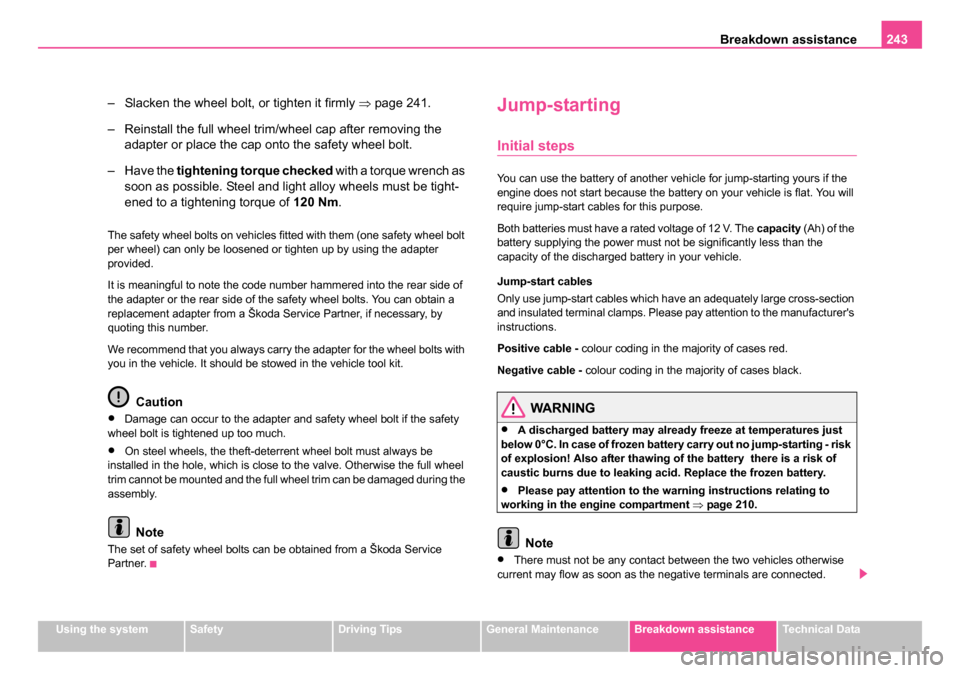
Breakdown assistance243
Using the systemSafetyDriving TipsGeneral MaintenanceBreakdown assistanceTechnical Data
– Slacken the wheel bolt, or tighten it firmly ⇒page 241.
– Reinstall the full wheel trim/wheel cap after removing the adapter or place the cap onto the safety wheel bolt.
– Have the tightening torque checked with a torque wrench as
soon as possible. Steel and light alloy wheels must be tight-
ened to a tightening torque of 120 Nm.
The safety wheel bolts on vehicles fitted with them (one safety wheel bolt
per wheel) can only be loosened or tighten up by using the adapter
provided.
It is meaningful to note the code number hammered into the rear side of
the adapter or the rear side of the safety wheel bolts. You can obtain a
replacement adapter from a Škoda Service Partner, if necessary, by
quoting this number.
We recommend that you always carry the adapter for the wheel bolts with
you in the vehicle. It should be stowed in the vehicle tool kit.
Caution
•Damage can occur to the adapter and safety wheel bolt if the safety
wheel bolt is tightened up too much.
•On steel wheels, the theft-deterrent wheel bolt must always be
installed in the hole, which is close to the valve. Otherwise the full wheel
trim cannot be mounted and the full wheel trim can be damaged during the
assembly.
Note
The set of safety wheel bolts can be obtained from a Škoda Service
Partner.
Jump-starting
Initial steps
You can use the battery of another vehicle for jump-starting yours if the
engine does not start because the battery on your vehicle is flat. You will
require jump-start cables for this purpose.
Both batteries must have a rated voltage of 12 V. The capacity (Ah) of the
battery supplying the power must not be significantly less than the
capacity of the discharged battery in your vehicle.
Jump-start cables
Only use jump-start cables which have an adequately large cross-section
and insulated terminal clamps. Please pay attention to the manufacturer's
instructions.
Positive cable - colour coding in the majority of cases red.
Negative cable - colour coding in the majority of cases black.
WARNING
•A discharged battery may already freeze at temperatures just
below 0°C. In case of frozen battery carry out no jump-starting - risk
of explosion! Also after thawing of the battery there is a risk of
caustic burns due to leaking acid. Replace the frozen battery.
•Please pay attention to the warning instructions relating to
working in the engine compartment ⇒page 210.
Note
•There must not be any contact between the two vehicles otherwise
current may flow as soon as the negative terminals are connected.
NKO 20 A05.book Page 243 Wednesday, June 21, 2006 1:42 PM
Page 245 of 274

Breakdown assistance
244
•The discharged battery must be properly connected to the system of
the vehicle.
•Switch off any installed telephone and also pay attention to the instruc-
tions for use of the telephone in such a situation.
•We recommend purchasing jump-start cables from Škoda Service
Partners as a Škoda original accessory or from retailers who sell branded
batteries.
Start engine
It is important to connect the jump-start cables in the correct
order.
Connecting positive terminals
– Attach one end to the positive terminal ⇒fig. 174 of the
discharged battery . – Attach the other end to the positive terminal of the battery
supplying the power .
Connecting negative terminal and engine block
– Attach one end to the negative terminal of the battery supplying the power .
– Attach the other end to a solid metal part which is connected firmly to the engine block, or to the engine block
itself ⇒ .
Starting engine
– Start the engine of the vehicle providing current and run the engine at idling speed.
– Now start the engine of the vehicle with the discharged battery.
– Interrupt the attempt at starting an engine after 10 seconds if it does not start right away and wait for about 30 seconds
before repeating the attempt.
– Disconnect the cables on the engine in exactly the reverse
order they were connected up.WARNING
•The non-insulated parts of the terminal clamps must never make
contact with each other. Furthermore, the cable connected to the
positive terminal of the battery must not come into contact with
electrically conducting parts of the vehicle - risk of a short circuit!
•Do not affix the jump starting cables to the negative terminal of
the discharged battery. There is the risk of detonating gas seeping
Fig. 174 Jump-starting
using the battery from
another vehicle: A - flat
vehicle battery, B -
battery providing
current
A1
AA
A2
AB
A3
AB
A4
NKO 20 A05.book Page 244 Wednesday, June 21, 2006 1:42 PM
Page 246 of 274

Breakdown assistance245
Using the systemSafetyDriving TipsGeneral MaintenanceBreakdown assistanceTechnical Data
out the battery being ignited by the strong spark which results from
the engine being started.
•Do not affix the cable end to parts of the fuel and brake
system.
•Run the jump-start cables so that they cannot be caught by any
rotating parts in the engine compartment.
•Do not bend over the batteries - risk of caustic burns!
•The vent screws of the battery cells must be tightened firmly.
•Keep any sources of ignition (naked flame, smouldering ciga-
rettes etc.) away from the battery - risk of an explosion!
Tow-starting and towing vehicle
General
Please pay attention to the following instructions if you are going
to use a tow rope:
Driver of the towing vehicle
– Do not drive off until the tow rope is taught.
– Release the clutch particularly gently when starting off. Driver of the towed vehicle
– Switch the ignition on so that the steering wheel is not blocked
and you can also operate the turn signal lights, the headlight
flasher, the windscreen wipers and windscreen washer
system.
– Take the vehicle out of gear or move the selector lever into position N if your vehicle is fitted with an automatic gearbox.
– Note that the brake servo unit and power steering only operate if the engine is running. You will require significantly greater
physical force to depress the brake pedal and to steer the
vehicle if the engine is not running.
– Ensure that the tow rope is always kept taught.
Tow rope or tow bar
A tow bar is safest way of towing a vehicle and also minimizes any
shocks. You can use a tow rope only if a suitable tow bar is not available.
The tow rope must be elastic to protect the vehicle. Thus one should only
use plastic fibre rope or a rope made out of a similarly elastic material.
Attach the tow rope or the tow bar only to the towing eyes provided for
this purpose ⇒page 246, “Front towing eye” and ⇒page 247, “Rear
towing eye”.
Driving style
Towing another vehicle requires a certain amount of practice. Both drivers
should be familiar with the particular points about towing a vehicle.
Unskilled drivers should not attempt to tow in another vehicle or to be
towed in.
One should be constantly vigilant not to allow impermissibly high towing
forces or jerky loadings. There is always a risk of excessive stresses and
WARNING (continued)
A4
NKO 20 A05.book Page 245 Wednesday, June 21, 2006 1:42 PM
Page 248 of 274

Breakdown assistance247
Using the systemSafetyDriving TipsGeneral MaintenanceBreakdown assistanceTechnical Data
Installing the towing eye
– Grasp the protective grille at the point marked with the arrow
and take it out ⇒fig. 175 .
– Screw in the towing eye by hand to the left up to the stop ⇒fig. 176 .
– Tighten up the towing eye using the wheel wrench (push the wheel wrench through eye).
Removal of the towing eye
– Unscrew the towing eye.
– Put the protective grille in place on the side opposite the marking.
– Press into place the protective grille onto the side facing the marking.
– The protective grille must engage firmly.Rear towing eye
The rear towing eye is located below the rear bumper on the right
⇒ fig. 177 .
Tow-starting a vehicle
If the engine does not start, we generally do not recommend to
tow-start your vehicle. One should attempt to start the engine
using jump start cables ⇒page 243 or call on the services of the
SERVICE mobile.
If your vehicle has to be towed:
– Engage 2nd or 3rd gear with the vehicle stationary.
– Depress the clutch pedal fully and keep it depressed.
Fig. 177 Rear towing
eye
NKO 20 A05.book Page 247 Wednesday, June 21, 2006 1:42 PM
Page 249 of 274
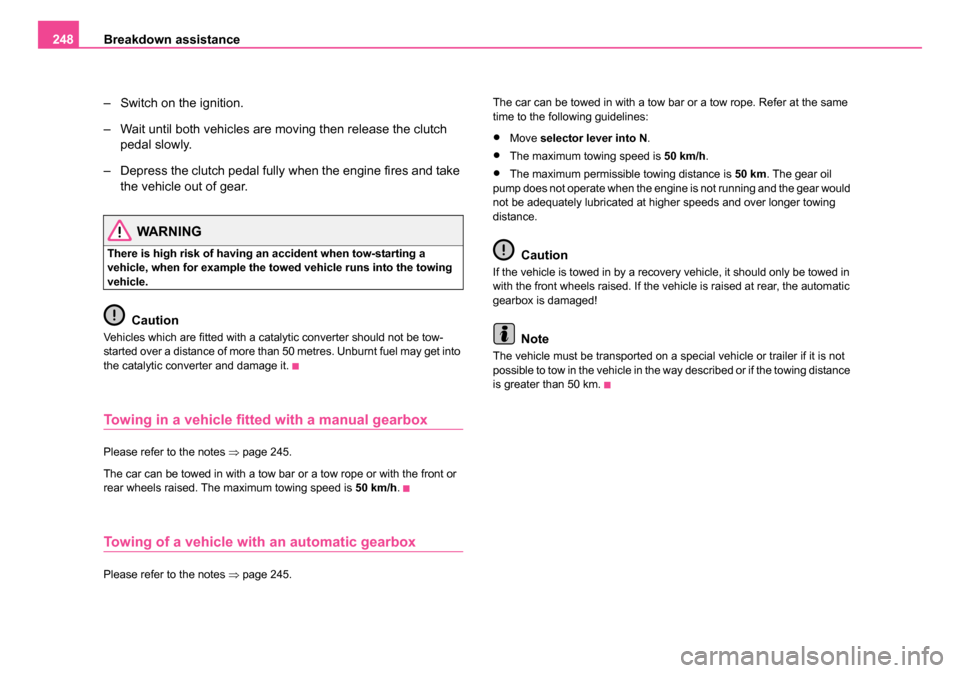
Breakdown assistance
248
– Switch on the ignition.
– Wait until both vehicles are moving then release the clutch pedal slowly.
– Depress the clutch pedal fully when the engine fires and take the vehicle out of gear.
WARNING
There is high risk of having an accident when tow-starting a
vehicle, when for example the towed vehicle runs into the towing
vehicle.
Caution
Vehicles which are fitted with a catalytic converter should not be tow-
started over a distance of more than 50 metres. Unburnt fuel may get into
the catalytic converter and damage it.
Towing in a vehicle fitted with a manual gearbox
Please refer to the notes ⇒page 245.
The car can be towed in with a tow bar or a tow rope or with the front or
rear wheels raised. The maximum towing speed is 50 km/h.
Towing of a vehicle with an automatic gearbox
Please refer to the notes ⇒page 245. The car can be towed in with a tow bar or a tow rope. Refer at the same
time to the following guidelines:
•Move
selector lever into N .
•The maximum towing speed is 50 km/h.
•The maximum permissible towing distance is 50 km. The gear oil
pump does not operate when the engine is not running and the gear would
not be adequately lubricated at higher speeds and over longer towing
distance.
Caution
If the vehicle is towed in by a recovery vehicle, it should only be towed in
with the front wheels raised. If the vehicle is raised at rear, the automatic
gearbox is damaged!
Note
The vehicle must be transported on a special vehicle or trailer if it is not
possible to tow in the vehicle in the way described or if the towing distance
is greater than 50 km.
NKO 20 A05.book Page 248 Wednesday, June 21, 2006 1:42 PM
Page 251 of 274
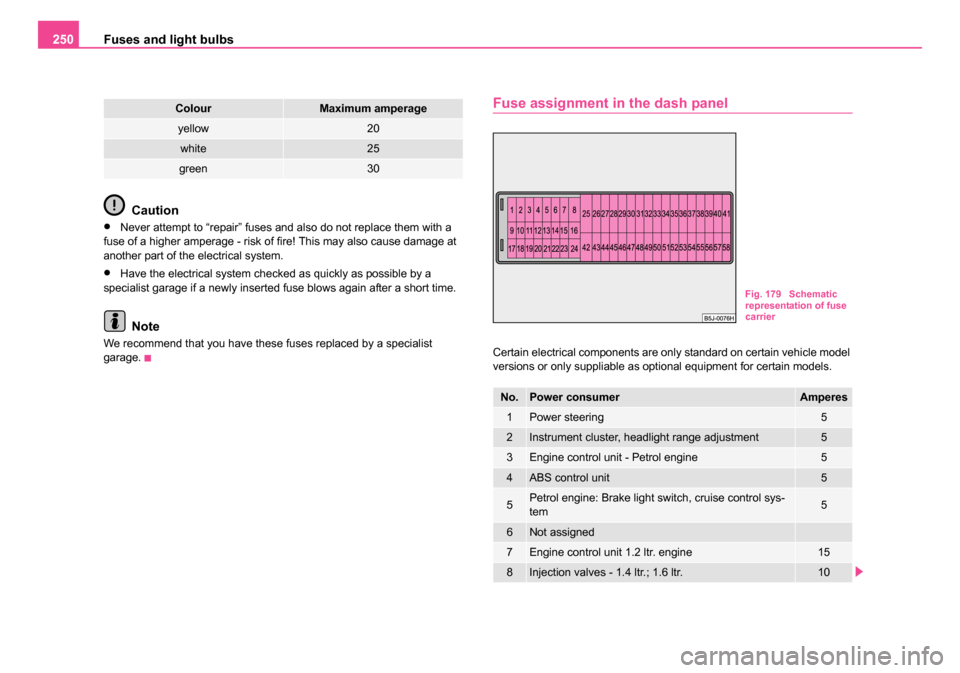
Fuses and light bulbs
250
Caution
•Never attempt to “repair” fuses and also do not replace them with a
fuse of a higher amperage - risk of fire! This may also cause damage at
another part of the electrical system.
•Have the electrical system checked as quickly as possible by a
specialist garage if a newly inserted fuse blows again after a short time.
Note
We recommend that you have these fuses replaced by a specialist
garage.
Fuse assignment in the dash panel
Certain electrical components are only standard on certain vehicle model
versions or only suppliable as optional equipment for certain models.
yellow20
white25
green30
ColourMaximum amperage
No.Power consumerAmperes
1Power steering5
2Instrument cluster, headlight range adjustment5
3Engine control unit - Petrol engine5
4ABS control unit5
5Petrol engine: Brake light switch, cruise control sys-
tem5
6Not assigned
7Engine control unit 1.2 ltr. engine15
8Injection valves - 1.4 ltr.; 1.6 ltr.10
Fig. 179 Schematic
representation of fuse
carrier
NKO 20 A05.book Page 250 Wednesday, June 21, 2006 1:42 PM
Page 252 of 274
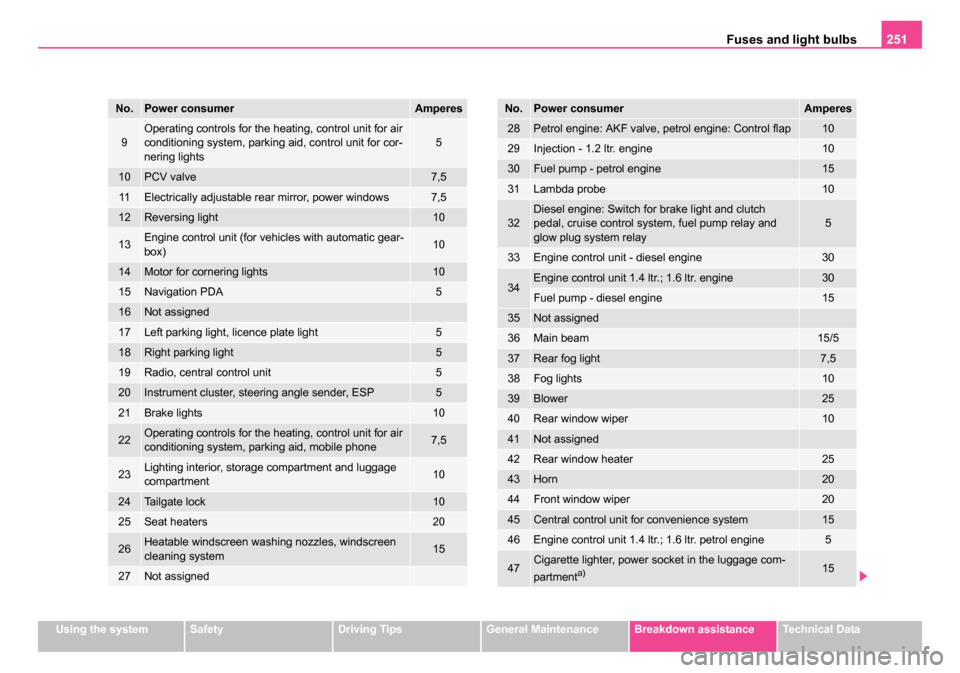
Fuses and light bulbs251
Using the systemSafetyDriving TipsGeneral MaintenanceBreakdown assistanceTechnical Data
9Operating controls for the heating, control unit for air
conditioning system, parking aid, control unit for cor-
nering lights5
10PCV valve7,5
11Electrically adjustable rear mirror, power windows7,5
12Reversing light10
13Engine control unit (for vehicles with automatic gear-
box)10
14Motor for cornering lights10
15Navigation PDA5
16Not assigned
17Left parking light, licence plate light5
18Right parking light5
19Radio, central control unit5
20Instrument cluster, steering angle sender, ESP5
21Brake lights10
22Operating controls for the heating, control unit for air
conditioning system, parking aid, mobile phone7,5
23Lighting interior, storage compartment and luggage
compartment10
24Tailgate lock10
25Seat heaters20
26Heatable windscreen washing nozzles, windscreen
cleaning system15
27Not assigned
No.Power consumerAmperes
28Petrol engine: AKF valve, petrol engine: Control flap10
29Injection - 1.2 ltr. engine10
30Fuel pump - petrol engine15
31Lambda probe10
32Diesel engine: Switch for brake light and clutch
pedal, cruise control system, fuel pump relay and
glow plug system relay5
33Engine control unit - diesel engine30
34Engine control unit 1.4 ltr.; 1.6 ltr. engine30
Fuel pump - diesel engine15
35Not assigned
36Main beam15/5
37Rear fog light7,5
38Fog lights10
39Blower25
40Rear window wiper10
41Not assigned
42Rear window heater25
43Horn20
44Front window wiper20
45Central control unit for convenience system15
46Engine control unit 1.4 ltr.; 1.6 ltr. petrol engine5
47Cigarette lighter, power socket in the luggage com-
partmenta)15
No.Power consumerAmperes
NKO 20 A05.book Page 251 Wednesday, June 21, 2006 1:42 PM
Page 253 of 274
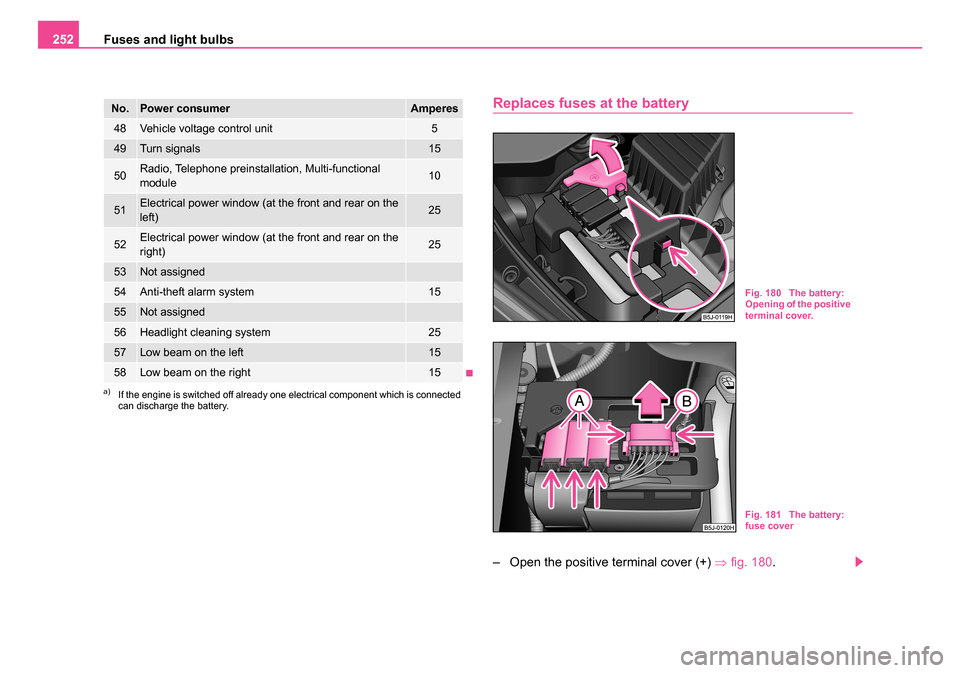
Fuses and light bulbs
252
Replaces fuses at the battery
– Open the positive terminal cover (+) ⇒fig. 180 .
48Vehicle voltage control unit5
49Turn signals15
50Radio, Telephone preinstallation, Multi-functional
module10
51Electrical power window (at the front and rear on the
left)25
52Electrical power window (at the front and rear on the
right)25
53Not assigned
54Anti-theft alarm system15
55Not assigned
56Headlight cleaning system25
57Low beam on the left15
58Low beam on the right15
a)If the engine is switched off already one electrical component which is connected
can discharge the battery.
No.Power consumerAmperes
Fig. 180 The battery:
Opening of the positive
terminal cover.
Fig. 181 The battery:
fuse cover
NKO 20 A05.book Page 252 Wednesday, June 21, 2006 1:42 PM
Page 255 of 274
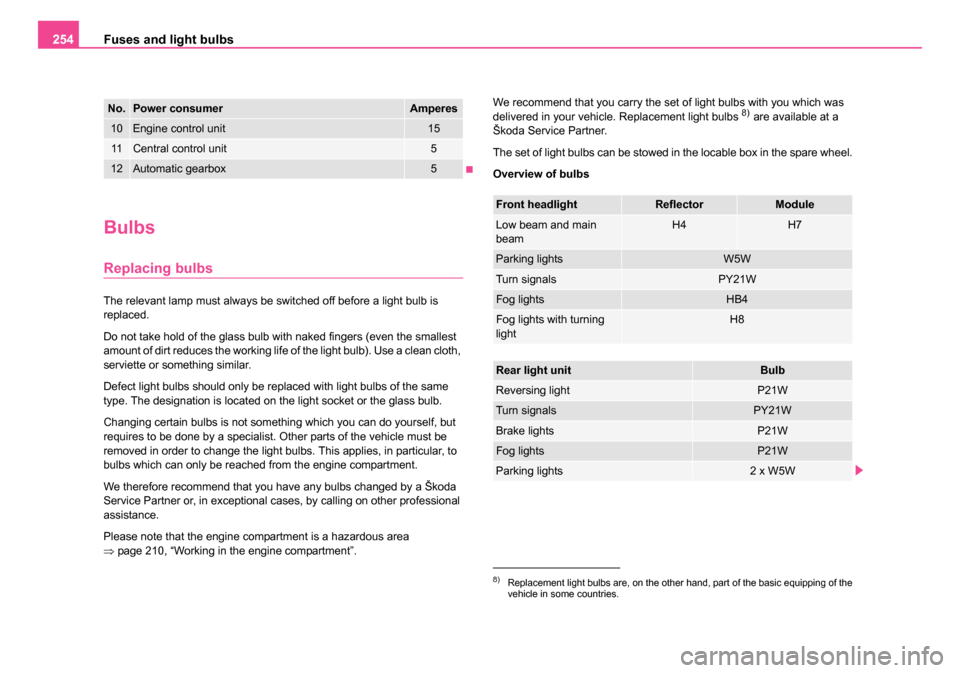
Fuses and light bulbs
254
Bulbs
Replacing bulbs
The relevant lamp must always be switched off before a light bulb is
replaced.
Do not take hold of the glass bulb with naked fingers (even the smallest
amount of dirt reduces the working life of the light bulb). Use a clean cloth,
serviette or something similar.
Defect light bulbs should only be replaced with light bulbs of the same
type. The designation is located on the light socket or the glass bulb.
Changing certain bulbs is not something which you can do yourself, but
requires to be done by a specialist. Other parts of the vehicle must be
removed in order to change the light bulbs. This applies, in particular, to
bulbs which can only be reached from the engine compartment.
We therefore recommend that you have any bulbs changed by a Škoda
Service Partner or, in exceptional cases, by calling on other professional
assistance.
Please note that the engine compartment is a hazardous area
⇒ page 210, “Working in the engine compartment”. We recommend that you carry the set of light bulbs with you which was
delivered in your vehicle. Replacement light bulbs
8) are available at a
Škoda Service Partner.
The set of light bulbs can be stowed in the locable box in the spare wheel.
Overview of bulbs10Engine control unit15
11Central control unit5
12Automatic gearbox5
No.Power consumerAmperes
8)Replacement light bulbs are, on the other hand, part of the basic equipping of the
vehicle in some countries.
Front headlightReflectorModule
Low beam and main
beamH4H7
Parking lightsW5W
Turn signalsPY21W
Fog lightsHB4
Fog lights with turning
lightH8
Rear light unitBulb
Reversing lightP21W
Turn signalsPY21W
Brake lightsP21W
Fog lightsP21W
Parking lights2 x W5W
NKO 20 A05.book Page 254 Wednesday, June 21, 2006 1:42 PM